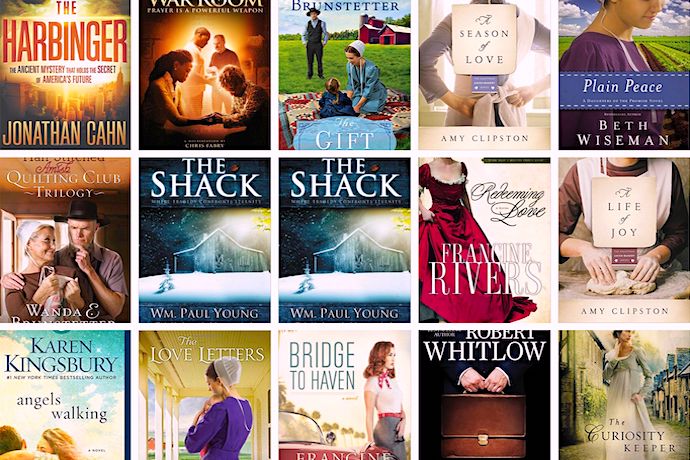Daniel Silliman’s new book, Reading Evangelicals: How Christian Fiction Shaped a Culture and a Faith, is an engaging history of evangelical fiction, focused on the infrastructure of publishers, distributors, and bookstores. A historian by training and current news editor of Christianity Today (as well as past contributor to RD), Silliman tells the fascinating story of the development of evangelical publishing by examining five influential bestselling Christian novels.

Reading Evangelicals: How Christian Fiction Shaped a Culture and a Faith
Daniel Silliman
Eerdmans
Oct 5, 2021
This new market came with different incentives, of course: fewer sales for denomination-specific books for Baptists or Presbyterians, but more sales potential for broader-themed books as factions discovered allies and a new “imagined community” of evangelicals emerged. Publishers such as Eerdmans and Zondervan mined this new market, with books about missionary lives; genres like testimonials; and self-help books about marriage, family and child-rearing.
These new “evangelical” publishers became successful in the 1950s, working with new evangelical bookstores that enjoyed huge growth since the 1970s—but which, Silliman tells us at the end of his book, are largely disappearing. Evangelical bookstores, for Silliman, constitute a “discourse community” alongside other “hubs of evangelical conversation” such as magazines, conferences, camps, seminaries and Bible colleges—elements that helped bring evangelical identity into being in the middle of the twentieth century, and are part of the larger alternative information ecosystem they inhabit. But even by the mid 1970s, no Christian publishers were regularly publishing popular fiction.
This all changed with Janette Oke’s 1979 historical romance Love Comes Softly, which “launch[ed] an industry of religious fiction.” Oke’s novel was about a young woman who experienced tragedy but found love and God in a Western frontier home. Oke had read hundreds of romance novels, but none treated religion in the meaningful way Oke experienced. A female editor at Bethany House eventually convinced her male colleagues to take a chance, and Love Comes Softly eventually became a bestseller. Oke wrote others, and, with imitators joining in, Christian historical romances flooded evangelical bookstores in the 1980s.
Silliman’s argument proceeds by drawing parallels between the bestsellers and their evangelical audiences. Love Comes Softly mirrored evangelical white women’s “proper” concerns with domesticity, child-rearing, and relation with God. A different mix of gender and genre would be Frank Peretti’s 1986 spiritual thriller This Present Darkness, which imagined a small town assailed by demons in the guise of New Age spirituality and foreign religious influences.
Silliman links the novel’s muscular engagement to the emergent Christian Right, showing how the new publisher Crossway was interested in promoting the idea of “cultural conflict”—an early version of today’s culture war—between an aggressive secular humanism and evangelical identity. Indebted to supernatural horror and thriller conventions, it was an “allegory for the social concerns of the Religious Right, who feel like they’re losing control of America. It’s the anxieties of conservative white Protestant men translated into a fantasy of cosmic struggle.”
The Left Behind series, meanwhile, reassured believers about their conversion and their theology, while driving unbelieving readers to make a choice between belief or unbelief, “a forced dichotomy.” Silliman shows how the 16-part series’ first novels didn’t hold much crossover appeal, but when Walmart distributed the fifth book as part of a strategy to identify with “white, middle American values,” sales took off, with the series eventually selling 80 million copies worldwide.
Less well known is Beverly Lewis’s 1997 The Shunning, about an Amish woman who discovers authentic identity and belief, and which, Silliman shows, reflects the marketing of authenticity associated with the Saddleback Church and Rick Warren’s The Purpose Driven Life.
The Shack, meanwhile, in its embrace of ambiguity and indeterminacy, is akin to the “emergent” evangelicals who disliked Left Behind and who saw belief as “experiential, rather than propositional,” a “relationship.” Eventually, Silliman reports, evangelical fiction became the largest category of sales in Christian bookstores after Bibles. These stores catered to laypeople, particularly middle-class suburban white women. But by the time The Shack was self-published in 2007, the evangelical bookstore was in rapid decline due to online and big box store sales.
The strongest dimension of the book is its account of the rise and fall of the evangelical bookstore read alongside the five bestsellers. And Silliman’s argument that evangelical fiction “shapes” the culture is significantly true: while I read This Present Darkness and the Left Behind series as more indebted to apocalyptic thinking than Silliman does, he is certainly correct that their cultural politics shaped evangelicals’ sense of embattlement and dichotomous thinking.
But in other examples, the argument might be better phrased as reflecting rather than shaping elements of evangelical culture. For example, Silliman is right that The Shack is a strikingly strange example of an evangelical bestseller because of its unusual theology and characterization of God, leading to charges of heresy against its author; I myself think Young has inadvertently rediscovered ancient Israelite polytheism. Young’s later embrace of “spiritual but not religious,” while not exactly a sign of becoming an exvangelical, does suggest a toleration of ambiguity and uncertainty unlike some of the “emergent” and “postmodern” churches Silliman compares Young with.
Indeed, as much as some evangelical churches imagined themselves to be “embrac[ing] the tension” and “becom[ing] postmodern,” the proof would always lay in the endurance of cultural conflict: their theological stances on gender and sexuality, white resentment and unwillingness to share power, and the pre-eminence of abortion as the apex of their concern for their fellow people. Christian postmodernism is not always an improvement. Silliman muses near the end of the book that a novel like The Shack suggests that evangelicalism’s boundaries may be becoming more permeable, its theologies more flexible. I hope he’s right, though I don’t share the optimism.
Thus the book’s Conclusion that “the best-selling fiction gave the wrong answers” surprises because it’s in tension with this hope and with Silliman’s prior neutrality. These evangelical bestsellers, he finally suggests, “prepared readers to imagine the world in certain ways and to embrace certain values. It prepared people to accept Trump as their political champion. Largely, they did.”
In their emphasis on individualism and nostalgia, their disinterest in the common good, their focus on personal freedom, and their hostility to pluralism, readers of the novels “are asked again and again to imagine how upsetting difference is.” Ultimately, evangelical fiction helped shape a culture of fear and resentment, the fruit of which we’ll unfortunately be confronting for years to come, not only with regard to traditional culture war issues, but also in the form of radical judicial appointees, a major party that supported and enabled an attempted coup, and even the destabilization of a common, agreed-upon reality.
Like all other human groups, evangelicals circulate knowledge by telling stories—and their stories don’t only come from the Bible, but also from popular fiction. Literary critics generally shy away from the evangelical fiction that’s been published since the 1970s, partly because we English professors regard it as too popular; it lacks artistry and its generally conservative theology is, I think, embarrassing to some scholars of faith. Fortunately, historians and social scientists, in contrast, have long paid attention to evangelical fiction for what it can tell us about this culturally important constituency. Silliman’s Reading Evangelicals is a good addition.





